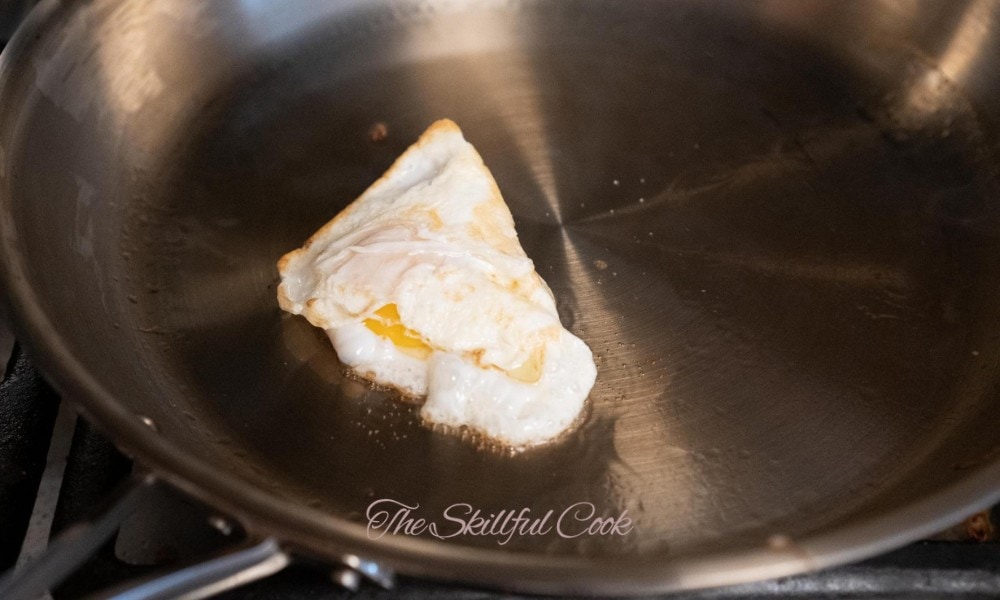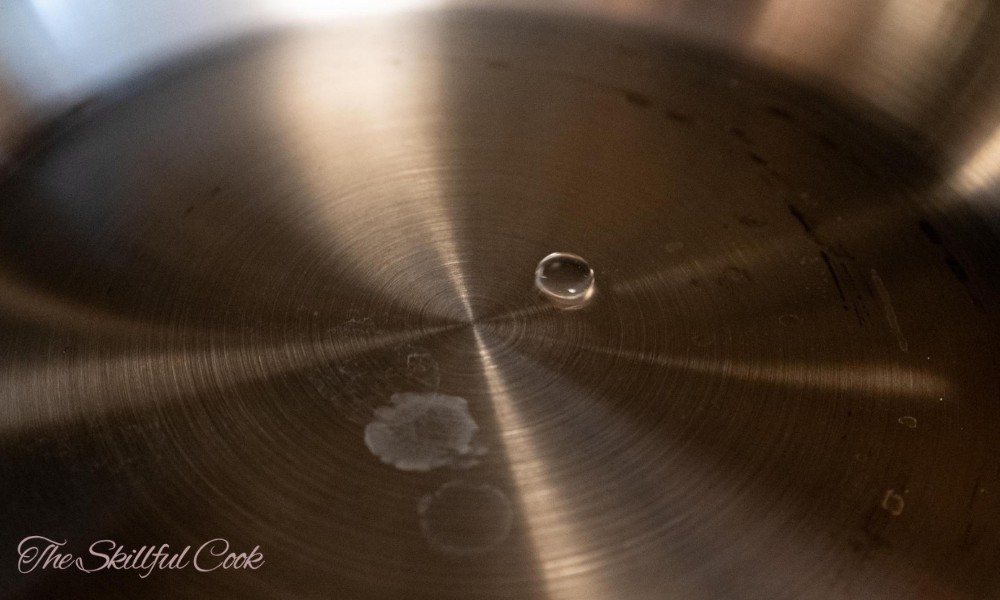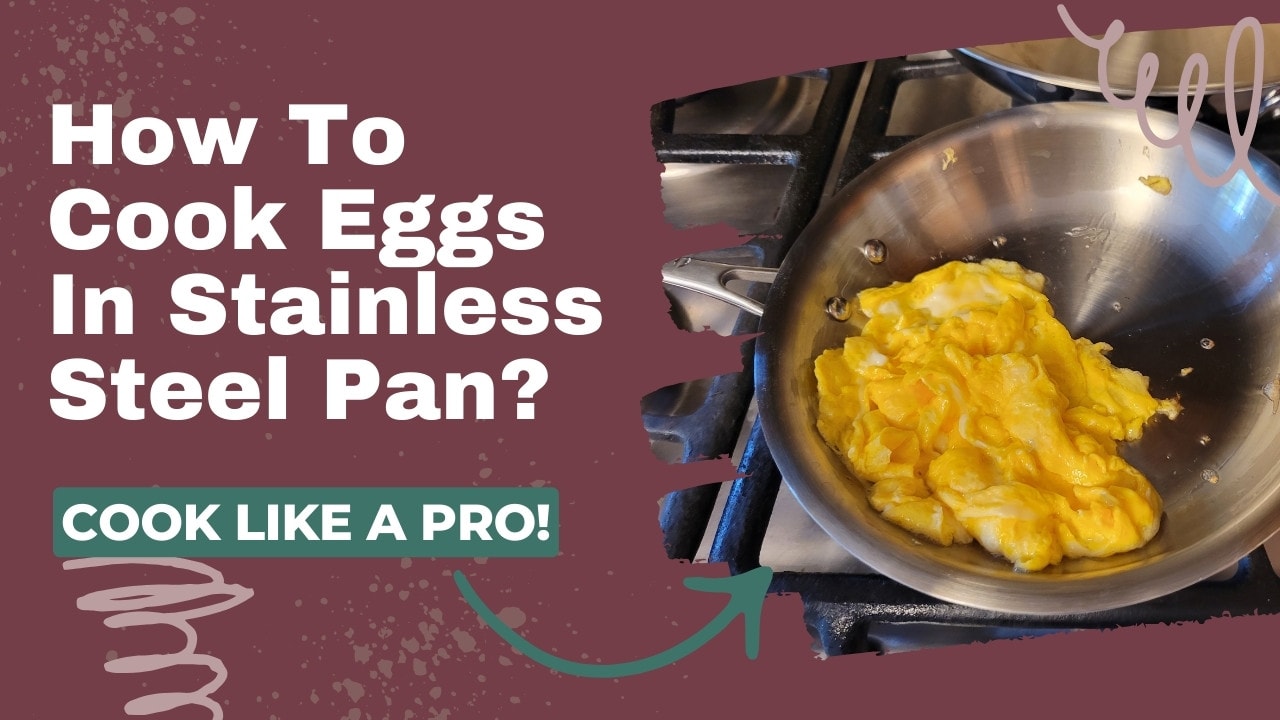How do you cook eggs in stainless steel? It’s simple! Place the pan over medium heat for a couple of minutes. To test if the pan is ready, pour a few drops of water in, and if the water forms a ball, it’s ready to go! Add your oil of choice and/or butter then your eggs.
After watching my mother cook eggs this way, then cooking them myself when her stainless steel cookware was passed down to me, I can safely say this is the way to cook eggs like a pro. After all, I’ve been doing it for nearly 40 years, so if it didn’t work, I’d try something else by now!
This page includes:
How Do You Fry Eggs in a Stainless Steel Pan?
Sunny-side-up, over-easy, scrambled, or the perfect omelet – no matter how you like your eggs, the basics of cooking them in stainless steel are the same. By placing the pan over medium heat and letting it heat up for a minute or two before adding oil, you’ll make it nonstick.
Let’s go through how to fry an egg on stainless steel step-by-step, just like you were standing next to me in my kitchen.
- Place your clean, empty stainless steel pan over medium heat.
- Let it heat for a couple of minutes while you grab the eggs, oil or butter, and any other ingredients like salt or pepper.
- Test if the pan temperature is ready. Add a couple of drops of water to the pan. If it sizzles, it’s not hot enough. But if the water pearls, rolling around the pan, then you’re good to go. This response of the water on the pan is called the Leidenfrost Effect and we cover that in more detail in the temperature section below.
- Add your cooking fat of choice and let that heat for about 5 seconds. I like olive oil sometimes with some butter mixed in. Remember if you use butter, it will brown and perhaps smoke a little. That’s okay, but you can reduce the effect by adding eggs quickly after the oil.
- Add your eggs to the pan and let them cook until you can lift them easily with a utensil. This is important. If your eggs are sticking, leave them a little longer and they will lift when properly cooked.
In the two-minute video below, French chef Bruno Albouze shows how to cook perfect sunny-side-up eggs in a stainless steel pan.
Temperature is the Secret to Perfect Eggs in Stainless Steel
Always heat your stainless steel cookware before you put anything on it, even oil.
The reason for this is that stainless steel, on a microscopic level, is porous. So when you heat the pan, those pores get smaller and smaller as the metal expands under the heat. This is how to make a stainless steel pan nonstick and easier to clean.

When the pores of the pan expand and seal so water cannot penetrate, it’s called the Leidenfrost Effect (or mercury effect). Emory University explains it on a molecular level here. Basically, that is why you place a few drops of water in the pan to tell if it’s ready to cook with. When the water hits the pan, a little will instantly evaporate so the rest of the drop coasts around on its steam like a hockey puck sliding across ice.
Does stainless steel need a steady temperature?
Yes. The wonder of nonstick stainless steel will last as long as you keep the temperature high enough to maintain the Leidenfrost effect.

Food sticks when the temperature drops – especially if it drops suddenly. This happens if you turn down the burner and add cold foods straight fron the fridge. Or worse, from the freezer. Do not add frozen foods straight to a hot stainless steel pan.
Trying to cook frozen foods can also cause thermal shock. If the temperature of the pan drops super quickly and drastically it can cause the pan to warp. It’s also dangerous for you! When you add frozen foods to hot oil, it will spit and sputter, throwing hot oil out of the pan and likely burning whoever is near it.
How to Cook Scrambled Eggs on Stainless Steel Without Sticking
Now let’s go through how to cook scrambled eggs step-by-step. The principle is the same whether you’re cooking for one or a family of six. The only difference is the size of the pan you will need. When making scrambled eggs, the initial steps are the same as frying an egg.
- Heat the stainless steel pan over medium heat. It will take up to five minutes depending on the type of stovetop you have. But always check if the heat is ready with a few drops of water just like we did when frying eggs.
- While the pan heats, prep your ingredients. Crack the eggs into a bowl and beat until one uniform smooth yellow color. Chop a little shallot, parsley, or fresh herbs if you like to add them to your scrambled eggs.
- Test the pan. Add a few drops of water. If the water sizzles, it needs a little longer. If it splashes then forms pearls, turn the heat down a little.
- Add your cooking fat of choice (enough to coat the bottom of the pan) and let that heat. Remember olive oil, vegetable oils, butter, ghee, lard, and bacon grease all have different rates of heating and smoke points. Butter has a low smoke point and will brown and smoke quickly, so you will need to add the eggs sooner. Olive oil is more forgiving and you have more time.
- Pour in your eggs. Let them sit for a minute until they lift by themselves. You may need to turn the heat down slightly if they’re cooking too fast.
- Stir the eggs gently, scraping them towards the center of the pan with a silicone spatula. Leave for a moment then repeat until the eggs are cooked. It only takes a couple of minutes.
- The eggs should come out clean, so all you have to do is rinse the pan under warm water and wipe dry.
- Store your stainless steel properly to prevent scratching.
This quick video shows how to test the stainless steel pan to start cooking and making perfect scrambled eggs.
Can You Fry Eggs on Stainless Steel Pans?
Yes. Stainless steel is perfect for frying eggs. Its even heat retention makes it ideal for cooking fried eggs, scrambled eggs, or making a perfect omelet.
Can You Make an Omelet in a Stainless Steel Pan?
Yes, stainless steel pans make a perfect omelet! In fact, most chefs the world over use stainless steel to make fabulous omelets. Let’s go through it step-by-step to see how chefs make perfect French omelets so that you can do it, too.
- Choose the right-sized pan. For a three-egg omelet, the ideal size is an 8-inch (20cm). This size means the omelet will turn out thick enough to support all the fillings.
- Heat the pan over medium heat.
- While the pan is heating, prep your ingredients. Grate some cheese, chop some chives, or whatever you like to add.
- Beat your eggs with a fork, not a whisk. A whisk adds in too much air. For perfect omelet eggs, add a dash of water – not milk or cream, which can be too heavy.
- Test to see if the pan is ready. Once your water pearls, then tip it out and add your butter. French omelets are always cooked with butter. If you’re lactose intolerant, you can use vegan butter, which tastes like butter but has no dairy in it. I’ve tried it, and it really does!
- When the butter has melted and stopped foaming, add the eggs.
- With one hand, shake the pan from side to side rapidly while the eggs cook. I know it sounds weird but it makes them soft and fluffy for the perfect omelet.
- Once the eggs are nearly cooked, add your chopped chives. When the omelet is fully cooked and ready, tilt the pan to one side so it slides down.
- If you like, place some cheese in the center and carefully slide the omelet out onto a plate folding it over as you do so. The heat from the eggs will melt the cheese and you are left with a perfect French omelet.
It may sound complicated but it’s easier than you think. Chef Christine Cushing, a classically trained French chef shows us how in the video below.
Frequently Asked Questions
Is it hard to cook eggs on a stainless steel skillet?
Not at all. Once the pan is heated to the correct temperature, just add oil and your eggs and cook. Let them cook until they lift with a spatula or egg flip. Don’t force them or they will stick. There are step-by-step instructions in the sections above.
How do you keep eggs from sticking to the pan?
Make sure to heat the pan for a few minutes over medium heat. Then test with a few drops of water. When they bead, forming a ball that rolls around the pan instead of sizzling, the pan is ready and you can add oil to start cooking the eggs.
How do you clean eggs off of a stainless steel pan?
When a skillet is preheated properly before cooking, the eggs should slide right out. All you need is a rinse under warm water and wipe the pan dry. If your eggs do stick, the pan wasn’t not enough or you didn’t let them cook enough to seal.
Egg residue is easy to remove. Add a little water to the bottom of the pan while it’s still hot and using a spatula gently scrape lifting the egg residue. For more stubborn residues add a dash of vinegar or some baking soda to the pan and gently lift with a spatula.
Conclusion
As I mentioned in the beginning, I’ve been cooking with stainless steel cookware my whole life and love it. My mother did too, her pots and pans are still going strong after 40 years in the kitchen.
When you heat stainless steel pans to the right temperature, they are a dream to cook eggs with. I’ve lived all over the world, from sea level to hilly cooler climates, and this method works anywhere no matter the humidity, altitude. It works on any kind of stove or heat source. As they say in Latin America, it’s the perfect way to cook huevos al gusto: eggs any way you like them.
Share your comments with us. We’d love to hear your cooking escapades and eggy adventures so drop us a line in the comments section below and we’ll get back to you as soon as we finish making eggs because we want omelets now!









